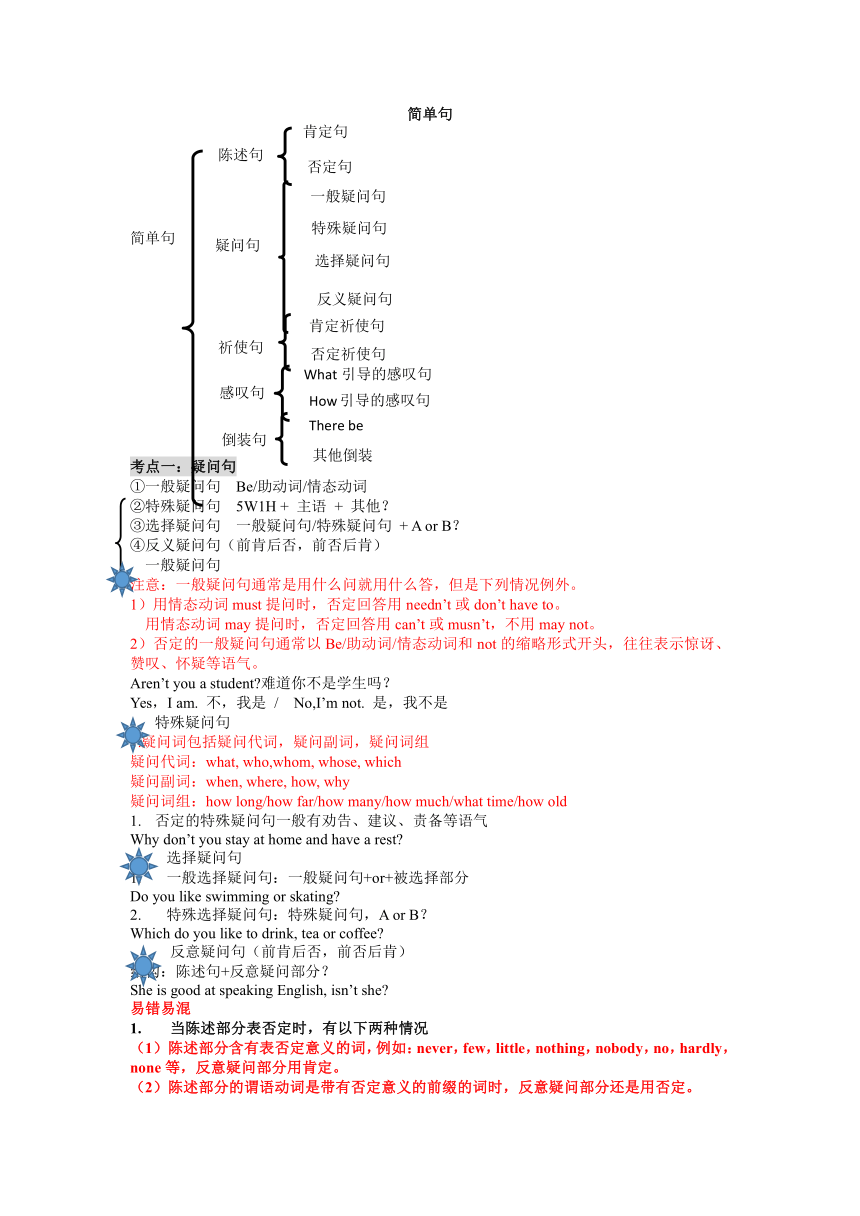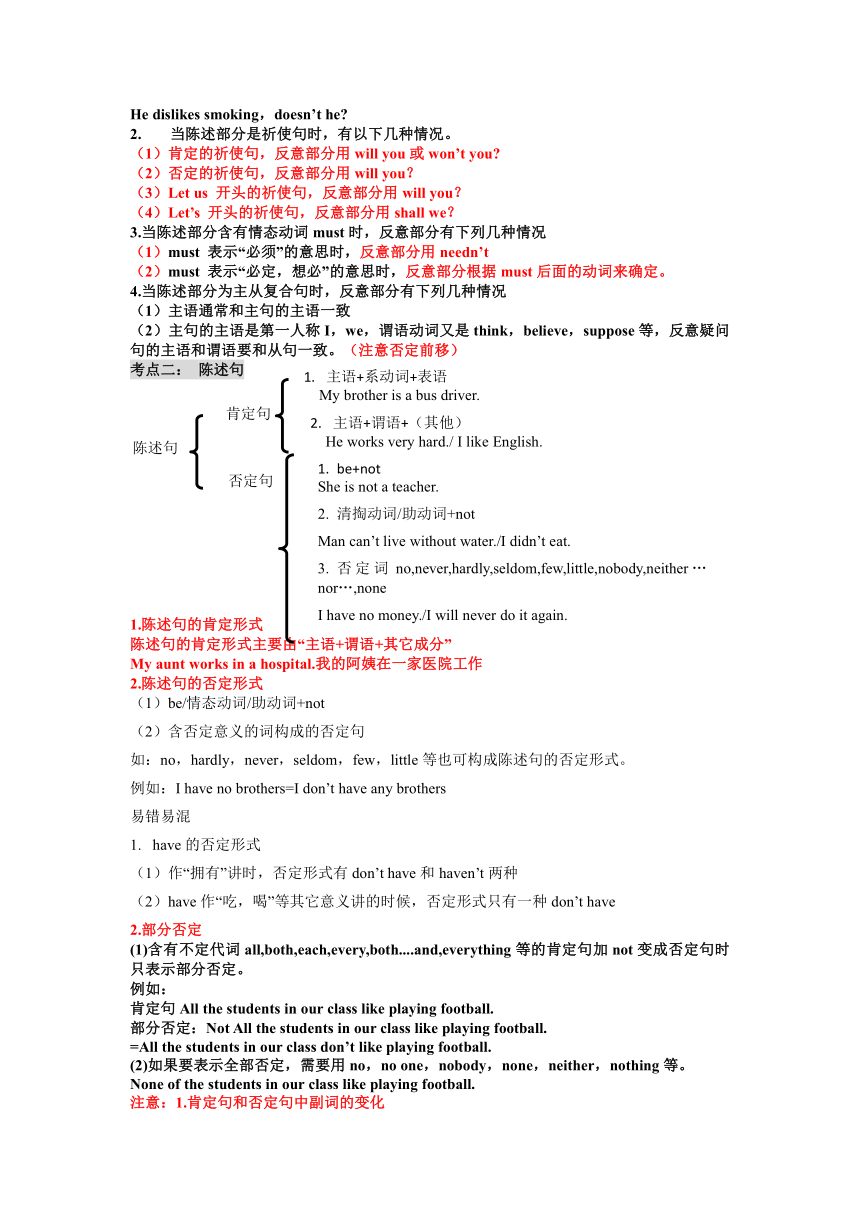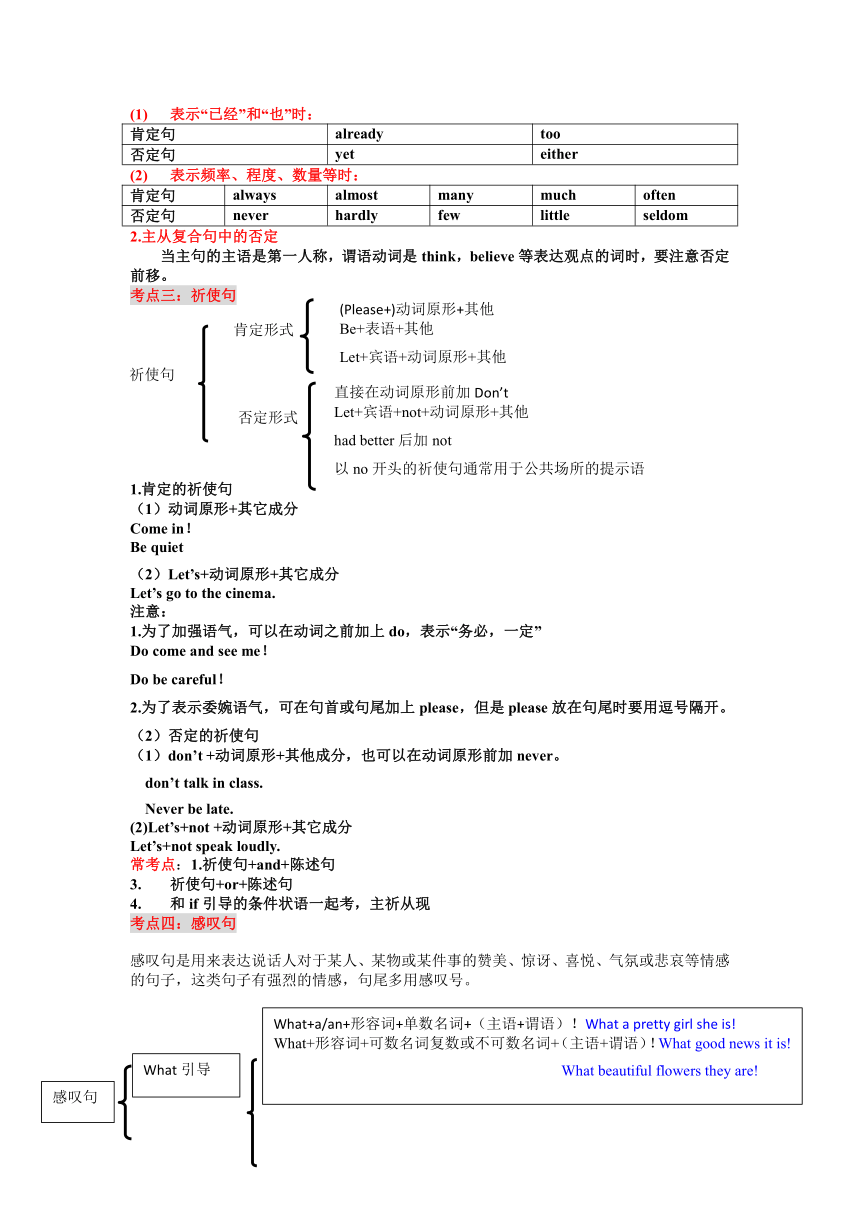2022年牛津译林版中考英语语法复习学案:简单句
文档属性
| 名称 | 2022年牛津译林版中考英语语法复习学案:简单句 |  | |
| 格式 | docx | ||
| 文件大小 | 133.8KB | ||
| 资源类型 | 试卷 | ||
| 版本资源 | 牛津译林版 | ||
| 科目 | 英语 | ||
| 更新时间 | 2022-05-15 06:47:44 | ||
图片预览




文档简介
简单句
简单句
考点一:疑问句
①一般疑问句 Be/助动词/情态动词
②特殊疑问句 5W1H + 主语 + 其他?
③选择疑问句 一般疑问句/特殊疑问句 + A or B?
④反义疑问句(前肯后否,前否后肯)
一般疑问句
注意:一般疑问句通常是用什么问就用什么答,但是下列情况例外。
用情态动词must提问时,否定回答用needn’t或don’t have to。
用情态动词may提问时,否定回答用can’t或musn’t,不用may not。
2)否定的一般疑问句通常以Be/助动词/情态动词和not的缩略形式开头,往往表示惊讶、赞叹、怀疑等语气。
Aren’t you a student 难道你不是学生吗?
Yes,I am. 不,我是 / No,I’m not. 是,我不是
特殊疑问句
1.疑问词包括疑问代词,疑问副词,疑问词组
疑问代词:what, who,whom, whose, which
疑问副词:when, where, how, why
疑问词组:how long/how far/how many/how much/what time/how old
否定的特殊疑问句一般有劝告、建议、责备等语气
Why don’t you stay at home and have a rest
选择疑问句
一般选择疑问句:一般疑问句+or+被选择部分
Do you like swimming or skating
特殊选择疑问句:特殊疑问句,A or B?
Which do you like to drink, tea or coffee
反意疑问句(前肯后否,前否后肯)
结构:陈述句+反意疑问部分?
She is good at speaking English, isn’t she
易错易混
当陈述部分表否定时,有以下两种情况
陈述部分含有表否定意义的词,例如:never,few,little,nothing,nobody,no,hardly,none等,反意疑问部分用肯定。
陈述部分的谓语动词是带有否定意义的前缀的词时,反意疑问部分还是用否定。
He dislikes smoking,doesn’t he
当陈述部分是祈使句时,有以下几种情况。
肯定的祈使句,反意部分用will you或won’t you
否定的祈使句,反意部分用will you?
Let us 开头的祈使句,反意部分用will you?
Let’s 开头的祈使句,反意部分用shall we?
3.当陈述部分含有情态动词must时,反意部分有下列几种情况
must 表示“必须”的意思时,反意部分用needn’t
must 表示“必定,想必”的意思时,反意部分根据must后面的动词来确定。
4.当陈述部分为主从复合句时,反意部分有下列几种情况
(1)主语通常和主句的主语一致
(2)主句的主语是第一人称I,we,谓语动词又是think,believe,suppose等,反意疑问句的主语和谓语要和从句一致。(注意否定前移)
考点二: 陈述句
1.陈述句的肯定形式
陈述句的肯定形式主要由“主语+谓语+其它成分”
My aunt works in a hospital.我的阿姨在一家医院工作
2.陈述句的否定形式
(1)be/情态动词/助动词+not
(2)含否定意义的词构成的否定句
如:no,hardly,never,seldom,few,little等也可构成陈述句的否定形式。
例如:I have no brothers=I don’t have any brothers
易错易混
have的否定形式
作“拥有”讲时,否定形式有don’t have和haven’t两种
have作“吃,喝”等其它意义讲的时候,否定形式只有一种don’t have
2.部分否定
(1)含有不定代词all,both,each,every,both....and,everything等的肯定句加not变成否定句时只表示部分否定。
例如:
肯定句All the students in our class like playing football.
部分否定:Not All the students in our class like playing football.
=All the students in our class don’t like playing football.
(2)如果要表示全部否定,需要用no,no one,nobody,none,neither,nothing等。
None of the students in our class like playing football.
注意:1.肯定句和否定句中副词的变化
表示“已经”和“也”时:
肯定句 already too
否定句 yet either
表示频率、程度、数量等时:
肯定句 always almost many much often
否定句 never hardly few little seldom
2.主从复合句中的否定
当主句的主语是第一人称,谓语动词是think,believe等表达观点的词时,要注意否定前移。
考点三:祈使句
1.肯定的祈使句
(1)动词原形+其它成分
Come in!
Be quiet
(2)Let’s+动词原形+其它成分
Let’s go to the cinema.
注意:
1.为了加强语气,可以在动词之前加上do,表示“务必,一定”
Do come and see me!
Do be careful!
2.为了表示委婉语气,可在句首或句尾加上please,但是please放在句尾时要用逗号隔开。
(2)否定的祈使句
(1)don’t +动词原形+其他成分,也可以在动词原形前加never。
don’t talk in class.
Never be late.
(2)Let’s+not +动词原形+其它成分
Let’s+not speak loudly.
常考点:1.祈使句+and+陈述句
祈使句+or+陈述句
和if引导的条件状语一起考,主祈从现
考点四:感叹句
感叹句是用来表达说话人对于某人、某物或某件事的赞美、惊讶、喜悦、气氛或悲哀等情感的句子,这类句子有强烈的情感,句尾多用感叹号。
注意:一些特殊形式的感叹句
(1)在陈述句或祈使句的句尾加感叹号变成感叹句,表示某种强烈的感情。
He eats so much!他吃的真多啊!
Do read it carefully!一定要仔细阅读啊!
(2)用一个词或词组表示强烈的感情也是感叹句
Look out!
Wonderful!
Great!
考点五:倒装句
一、倒装句的定义
主语和谓语是句子的核心,它们之间有两种语序:一是主语在谓语之前称为自然语序(Natural Order)/陈述语序;二是主语在谓语之后则称为倒装语序(Inverted Order)。为了强调、突出等语的目的而颠倒原有语序的句式叫做倒装句。在倒装句中,颠倒了的成分可以恢复原位而句意基本不变,句法成分不变。
二、完全倒装
1. 完全倒装是将谓语全部放在主语之前,此结构通常只用于一般现在时和一般过去时。
*Up went the rocket into the air.
嗖地火箭就飞上天了。
*Inside the classroom are the students and the teacher.
老师和学生在教室里。
2. 常见的完全倒装结构:
(1)状语在句首
here, there, now, then, thus等简短副词或above, away, in, out 等方位副词于句首,谓语动词常用be, come, go, lie, run等动词。
*Then came another question. 接着又一个问题提出来了。
*Look, here comes the taxi. 瞧,出租车过来了。
表示地点的介词短语(如on the wall, under the tree, in front of the house, in the middle of the room等)放在句首时。
*Under a big tree sat a little boy. 一个小男孩坐在树下。
South of the lake lies a big supermarket. 湖的南边是一个大超市。
【注意】这种倒装中,主语必须是名词,主语是人称代词时,主语和谓语语序不变。
*In he came and the lesson began.
他走进来开始上课。
铃一响,学生就冲出去了。
Hearing the bell ring, out rushed the students .
Hearing the bell ring, out they rushed.
(2)表语置于句首时,倒装结构为“表语+连系动词+主语”。
*Present at the meeting was Mr Green, a headmaster with his friends.
校长格林先生和他的朋友们出席了会议。
Seated on the ground are a group of young people.
坐在地上的是一群年轻人。
(1) Here is the letter you have been looking forward to.
你盼望已久的信在这儿。
(2) Gone are the days when women were looked down upon.
妇女受歧视的日子一去不复返了。
三、部分倒装
1. 部分倒装是指将谓语的一部分,如助动词或情态动词,移至主语之前。
*Little did he know who the woman was.
他不太知道那个女的是谁。
*Only in this way can you master English.
只有这样你才能掌握英语。
2. 常见的部分倒装的结构。
(1)含有否定意义的否定词或半否定词包括短语(如never, neither, nor, little, seldom, rarely, hardly, scarcely, few, not, no, by no means, in no way, at no time等)放在句首时。
*Little did I dream of seeing such wonderful scenery.
我做梦也没想到会看到这样美妙的景色。
*Never shall I do this silly thing again.
我再不会做这种傻事了。
【注意】
1.“Not only+分句,but also+分句”句型中的前一分句要部分倒装。
*Not only can he speak English, but he can also speak Japanese fluently.
他不但会讲英语,而且还能流利地讲日语。
2. 表示“刚/一……就……”的倒装句型。
*Hardly had the game begun when it started raining.
比赛刚刚开始就下起了雨来。
*No sooner had he arrived in Rome than he was kidnapped.
他刚到罗马就遭到了绑架。
*Scarcely had I come in when the phone rang.
我刚刚一进去,电话就响了。
3. Not until 句型
直到我妈回来我才有手机上传作业。
I didn’t get the mobile phone to upload the assignment until my mother came back.
It was not until my mother came back that I got the mobile phone to upload the assignment.
Not until my mother came back did I get the mobile phone to upload the assignment.
直到新冠消除我们才会上学。
Not until the coronavirus is wiped out will we go back to school.
4. in no time 放在句首不需要倒装
(2)副词 only修饰状语置于句首时。
*Only then did he realize the importance of his family.
只有在那时他才意识到家人的重要性。
*Only in this way can you solve this problem.
只有用这种方法, 你才可以解决这个问题。
*Only when the war was over in 1918 was he able to get back to work. 直到1918年战争结束,他才能回去工作。
只有他能回答这个问题。
*Only he can answer the question.
(3) as引导的让步状语从句(as可以换成though)。
a. 表语(形容词/名词)+ as+ 主语+ 系动词
*Famous as he is, he is easygoing.
尽管他很有名气,但他很平易近人。
*Child as/though he is, he knows a lot.
尽管他是个孩子,但他懂得很多。
b. 副词+ as+主语+谓语动词
*Hard as he tried, he couldn’t pass the exam.
尽管他努力了,他还是没有通过考试。
c. 动词原形 +as+ 主语+ might/may
*Try as she may, she won’t pass it.
尽管愿意再试,她还是不会通过的。
【注意】实义动词放在句首时,其他助动词放在主语后。
*Try as I might, I could not lift the stone.
我用尽力气,可还是举不起这块石头。
(4)“so. . . that. . . ”和“such. . . that. . . ”结构中的so或such位于句首时。
*So fast does light travel that we can hardly imagine its speed.
光运行得非常快,我们几乎无法想象它的速度。
*Such a lovely toy did he buy me that I was very thankful to him.
他给我买了这么可爱的一个玩具,我非常感激他。
(5)在虚拟条件句中,从句的谓语含有were, had 和should这三个词时,可省去if,将这些词移至主语之前构成部分倒装。
如果我是你,我不会让这么好的一个机会溜走的。
*Were I you(=If I were you), I wouldn’t have such a good chance slip.
如果明天下雨,我们就待在室内看书。
*Should it rain tomorrow(=If it should rain tomorrow), we would stay indoors reading books.
要是你参加了毕业典礼,我就会见到你了。
*Had you attended(=If you had attended) the graduate ceremony, I should have seen you.
(6)so作“也”讲时,引导的句子用倒装语序,表示前面所说的也适用于另一个人或事物,表示“……也(不)是如此”。其句型是: so/neither/nor+be动词/助动词/情态动词+主语。
他能游泳。我也能游泳。
*He can swim. So can I.
昨天晚上他去看电影了。我也去了。
*He went to the film last night. So did I.
我不知道他住哪儿。她也不知道。
*I don’t know where he lives. Neither does she.
【注意】
①当so引出的句子是用以对上文内容的证实或肯定,表示“的确如此”时,不用倒装结构。
*—He works very hard. 他学习很努力。
—So he does and so do you. 他的确如此,你也是。
②若表示一个人的两个或者两个以上的情况,也适用于另一个人,则用句型: So it is/was with sb. 或者It is/was the same with sb. 。
*—He was born in Shanghai and brought up in Beijing.
他在上海出生,在北京长大。
—It was the same with my friend Li Ping.
我朋友李平也是。
so/neither/nor 的倒装句
So+主语+情/系/助 (的确如此) 和上文/前句的主语是同一人
So +情/系/助+主语 (某人也一样) 和上文/前句的主语非同一人
否定
Neither/Nor +情/系/助+主语(某人也不) 和上文/前句的主语非同一人
且前句/上文为否定句
考点六:六种基本句型(含there be 句型)
主语:是句子要说明的人或物。一般由名词、代词、不定式,动名词充当。
Telling a lie is wrong.
Learning a foreign language takes a long time.
谓语:说明主语的动作、状态、或特征,表示“干什么,是什么,怎么样?谓语和主语要在“人称”和“数”两方面必须保持一致。
He goes to work every day.
They are swimming.
We must work hard at English.
宾语:表示行为动作的对象,是动作的承受者,一般由名词、代词、或动名词、不定式充当。
The child needs help.
I hope to see you again.
Tom likes swimming.
宾语补足语:有些动词若只带一个宾语,句子意义还不是很完整,须另带一部分来说明宾语的情况或状态,这一部分就叫宾语补足语。宾语和宾语补足语合称为复合宾语:
We found the story quite interesting.
We asked him to help us.
状语:用来修饰动词、形容词或副词,也可以修饰整个句子。通常由副词、介词短语、分词、不定式、从句来充当。
He was born in Shanghai in 1990.
Suddenly it began to rain.
定语:用来修饰名词或代词,通常由形容词、数词、不定式、分词、介词短语、从句来充当。有前置定语和后置定语之分。
Our classroom is clean and bright.
The man in a brown jacket is my father.
简单句五种基本句型
简单句的五种基本句型,关键在于谓语动词。
主+系+表 (S+V+P)
Time is money.(时间就是金钱)
主+谓(S+V)
Time flies.(时光飞逝)
Time brings us experience.(时间带给我们经验)
主+谓+间接宾语+直接宾语(S+V+IO+DO)
The little boy grew up. 间接宾语和直接宾语合起来叫双宾语。
主+谓+宾(S+V+O)
He lent me ten yuan.
主+谓+宾语+宾语补足语(S+V+O+OC)
It makes him happy.
I found this answer wrong.
六:there be 句型(就近原则,there不能和have连用)
there be 句型中的be有时可以用used to be来替换。
就近原则
就近原则也称“邻近原则”,即:谓语与靠近的名词、代词在“人称、数”上一致。
这些词组有there be ……句型, Neither……nor……, Either……or…… , Not……but…… , Not only……but also……,
1.There be 句型
There is a book and some pencils on the desk.
=There are some pencils and a book on the desk.
类似的还有here 和 This. Here is a man and woman
2.neither...nor...
Neither you nor he is right. = Neither he nor you are right.
Neither you nor I am wrong. = Neither I nor you are wrong.
3.either...or...
Either they or Jim is going to Shanghai next Saturday.
= Either Jim or they are going to shanghai next Saturday.
4.not only...but also...
Not only Ann but also her parents stay at home every Sunday.
= Not only Ann's parents but also she stays at home every Sunday.
Not only the students but also the teacher wishes for a holiday.
Not only they but also I am keen on sports.
就远原则
当主语后面与(together/along)with,as well as,but,except,like,rather than,no less than,besides,including等+名词或代词连用时,谓语动词与第一个主语保持一致。
例子:He rather than I is right.
Nobody but two students is in the classroom.
简单句
考点一:疑问句
①一般疑问句 Be/助动词/情态动词
②特殊疑问句 5W1H + 主语 + 其他?
③选择疑问句 一般疑问句/特殊疑问句 + A or B?
④反义疑问句(前肯后否,前否后肯)
一般疑问句
注意:一般疑问句通常是用什么问就用什么答,但是下列情况例外。
用情态动词must提问时,否定回答用needn’t或don’t have to。
用情态动词may提问时,否定回答用can’t或musn’t,不用may not。
2)否定的一般疑问句通常以Be/助动词/情态动词和not的缩略形式开头,往往表示惊讶、赞叹、怀疑等语气。
Aren’t you a student 难道你不是学生吗?
Yes,I am. 不,我是 / No,I’m not. 是,我不是
特殊疑问句
1.疑问词包括疑问代词,疑问副词,疑问词组
疑问代词:what, who,whom, whose, which
疑问副词:when, where, how, why
疑问词组:how long/how far/how many/how much/what time/how old
否定的特殊疑问句一般有劝告、建议、责备等语气
Why don’t you stay at home and have a rest
选择疑问句
一般选择疑问句:一般疑问句+or+被选择部分
Do you like swimming or skating
特殊选择疑问句:特殊疑问句,A or B?
Which do you like to drink, tea or coffee
反意疑问句(前肯后否,前否后肯)
结构:陈述句+反意疑问部分?
She is good at speaking English, isn’t she
易错易混
当陈述部分表否定时,有以下两种情况
陈述部分含有表否定意义的词,例如:never,few,little,nothing,nobody,no,hardly,none等,反意疑问部分用肯定。
陈述部分的谓语动词是带有否定意义的前缀的词时,反意疑问部分还是用否定。
He dislikes smoking,doesn’t he
当陈述部分是祈使句时,有以下几种情况。
肯定的祈使句,反意部分用will you或won’t you
否定的祈使句,反意部分用will you?
Let us 开头的祈使句,反意部分用will you?
Let’s 开头的祈使句,反意部分用shall we?
3.当陈述部分含有情态动词must时,反意部分有下列几种情况
must 表示“必须”的意思时,反意部分用needn’t
must 表示“必定,想必”的意思时,反意部分根据must后面的动词来确定。
4.当陈述部分为主从复合句时,反意部分有下列几种情况
(1)主语通常和主句的主语一致
(2)主句的主语是第一人称I,we,谓语动词又是think,believe,suppose等,反意疑问句的主语和谓语要和从句一致。(注意否定前移)
考点二: 陈述句
1.陈述句的肯定形式
陈述句的肯定形式主要由“主语+谓语+其它成分”
My aunt works in a hospital.我的阿姨在一家医院工作
2.陈述句的否定形式
(1)be/情态动词/助动词+not
(2)含否定意义的词构成的否定句
如:no,hardly,never,seldom,few,little等也可构成陈述句的否定形式。
例如:I have no brothers=I don’t have any brothers
易错易混
have的否定形式
作“拥有”讲时,否定形式有don’t have和haven’t两种
have作“吃,喝”等其它意义讲的时候,否定形式只有一种don’t have
2.部分否定
(1)含有不定代词all,both,each,every,both....and,everything等的肯定句加not变成否定句时只表示部分否定。
例如:
肯定句All the students in our class like playing football.
部分否定:Not All the students in our class like playing football.
=All the students in our class don’t like playing football.
(2)如果要表示全部否定,需要用no,no one,nobody,none,neither,nothing等。
None of the students in our class like playing football.
注意:1.肯定句和否定句中副词的变化
表示“已经”和“也”时:
肯定句 already too
否定句 yet either
表示频率、程度、数量等时:
肯定句 always almost many much often
否定句 never hardly few little seldom
2.主从复合句中的否定
当主句的主语是第一人称,谓语动词是think,believe等表达观点的词时,要注意否定前移。
考点三:祈使句
1.肯定的祈使句
(1)动词原形+其它成分
Come in!
Be quiet
(2)Let’s+动词原形+其它成分
Let’s go to the cinema.
注意:
1.为了加强语气,可以在动词之前加上do,表示“务必,一定”
Do come and see me!
Do be careful!
2.为了表示委婉语气,可在句首或句尾加上please,但是please放在句尾时要用逗号隔开。
(2)否定的祈使句
(1)don’t +动词原形+其他成分,也可以在动词原形前加never。
don’t talk in class.
Never be late.
(2)Let’s+not +动词原形+其它成分
Let’s+not speak loudly.
常考点:1.祈使句+and+陈述句
祈使句+or+陈述句
和if引导的条件状语一起考,主祈从现
考点四:感叹句
感叹句是用来表达说话人对于某人、某物或某件事的赞美、惊讶、喜悦、气氛或悲哀等情感的句子,这类句子有强烈的情感,句尾多用感叹号。
注意:一些特殊形式的感叹句
(1)在陈述句或祈使句的句尾加感叹号变成感叹句,表示某种强烈的感情。
He eats so much!他吃的真多啊!
Do read it carefully!一定要仔细阅读啊!
(2)用一个词或词组表示强烈的感情也是感叹句
Look out!
Wonderful!
Great!
考点五:倒装句
一、倒装句的定义
主语和谓语是句子的核心,它们之间有两种语序:一是主语在谓语之前称为自然语序(Natural Order)/陈述语序;二是主语在谓语之后则称为倒装语序(Inverted Order)。为了强调、突出等语的目的而颠倒原有语序的句式叫做倒装句。在倒装句中,颠倒了的成分可以恢复原位而句意基本不变,句法成分不变。
二、完全倒装
1. 完全倒装是将谓语全部放在主语之前,此结构通常只用于一般现在时和一般过去时。
*Up went the rocket into the air.
嗖地火箭就飞上天了。
*Inside the classroom are the students and the teacher.
老师和学生在教室里。
2. 常见的完全倒装结构:
(1)状语在句首
here, there, now, then, thus等简短副词或above, away, in, out 等方位副词于句首,谓语动词常用be, come, go, lie, run等动词。
*Then came another question. 接着又一个问题提出来了。
*Look, here comes the taxi. 瞧,出租车过来了。
表示地点的介词短语(如on the wall, under the tree, in front of the house, in the middle of the room等)放在句首时。
*Under a big tree sat a little boy. 一个小男孩坐在树下。
South of the lake lies a big supermarket. 湖的南边是一个大超市。
【注意】这种倒装中,主语必须是名词,主语是人称代词时,主语和谓语语序不变。
*In he came and the lesson began.
他走进来开始上课。
铃一响,学生就冲出去了。
Hearing the bell ring, out rushed the students .
Hearing the bell ring, out they rushed.
(2)表语置于句首时,倒装结构为“表语+连系动词+主语”。
*Present at the meeting was Mr Green, a headmaster with his friends.
校长格林先生和他的朋友们出席了会议。
Seated on the ground are a group of young people.
坐在地上的是一群年轻人。
(1) Here is the letter you have been looking forward to.
你盼望已久的信在这儿。
(2) Gone are the days when women were looked down upon.
妇女受歧视的日子一去不复返了。
三、部分倒装
1. 部分倒装是指将谓语的一部分,如助动词或情态动词,移至主语之前。
*Little did he know who the woman was.
他不太知道那个女的是谁。
*Only in this way can you master English.
只有这样你才能掌握英语。
2. 常见的部分倒装的结构。
(1)含有否定意义的否定词或半否定词包括短语(如never, neither, nor, little, seldom, rarely, hardly, scarcely, few, not, no, by no means, in no way, at no time等)放在句首时。
*Little did I dream of seeing such wonderful scenery.
我做梦也没想到会看到这样美妙的景色。
*Never shall I do this silly thing again.
我再不会做这种傻事了。
【注意】
1.“Not only+分句,but also+分句”句型中的前一分句要部分倒装。
*Not only can he speak English, but he can also speak Japanese fluently.
他不但会讲英语,而且还能流利地讲日语。
2. 表示“刚/一……就……”的倒装句型。
*Hardly had the game begun when it started raining.
比赛刚刚开始就下起了雨来。
*No sooner had he arrived in Rome than he was kidnapped.
他刚到罗马就遭到了绑架。
*Scarcely had I come in when the phone rang.
我刚刚一进去,电话就响了。
3. Not until 句型
直到我妈回来我才有手机上传作业。
I didn’t get the mobile phone to upload the assignment until my mother came back.
It was not until my mother came back that I got the mobile phone to upload the assignment.
Not until my mother came back did I get the mobile phone to upload the assignment.
直到新冠消除我们才会上学。
Not until the coronavirus is wiped out will we go back to school.
4. in no time 放在句首不需要倒装
(2)副词 only修饰状语置于句首时。
*Only then did he realize the importance of his family.
只有在那时他才意识到家人的重要性。
*Only in this way can you solve this problem.
只有用这种方法, 你才可以解决这个问题。
*Only when the war was over in 1918 was he able to get back to work. 直到1918年战争结束,他才能回去工作。
只有他能回答这个问题。
*Only he can answer the question.
(3) as引导的让步状语从句(as可以换成though)。
a. 表语(形容词/名词)+ as+ 主语+ 系动词
*Famous as he is, he is easygoing.
尽管他很有名气,但他很平易近人。
*Child as/though he is, he knows a lot.
尽管他是个孩子,但他懂得很多。
b. 副词+ as+主语+谓语动词
*Hard as he tried, he couldn’t pass the exam.
尽管他努力了,他还是没有通过考试。
c. 动词原形 +as+ 主语+ might/may
*Try as she may, she won’t pass it.
尽管愿意再试,她还是不会通过的。
【注意】实义动词放在句首时,其他助动词放在主语后。
*Try as I might, I could not lift the stone.
我用尽力气,可还是举不起这块石头。
(4)“so. . . that. . . ”和“such. . . that. . . ”结构中的so或such位于句首时。
*So fast does light travel that we can hardly imagine its speed.
光运行得非常快,我们几乎无法想象它的速度。
*Such a lovely toy did he buy me that I was very thankful to him.
他给我买了这么可爱的一个玩具,我非常感激他。
(5)在虚拟条件句中,从句的谓语含有were, had 和should这三个词时,可省去if,将这些词移至主语之前构成部分倒装。
如果我是你,我不会让这么好的一个机会溜走的。
*Were I you(=If I were you), I wouldn’t have such a good chance slip.
如果明天下雨,我们就待在室内看书。
*Should it rain tomorrow(=If it should rain tomorrow), we would stay indoors reading books.
要是你参加了毕业典礼,我就会见到你了。
*Had you attended(=If you had attended) the graduate ceremony, I should have seen you.
(6)so作“也”讲时,引导的句子用倒装语序,表示前面所说的也适用于另一个人或事物,表示“……也(不)是如此”。其句型是: so/neither/nor+be动词/助动词/情态动词+主语。
他能游泳。我也能游泳。
*He can swim. So can I.
昨天晚上他去看电影了。我也去了。
*He went to the film last night. So did I.
我不知道他住哪儿。她也不知道。
*I don’t know where he lives. Neither does she.
【注意】
①当so引出的句子是用以对上文内容的证实或肯定,表示“的确如此”时,不用倒装结构。
*—He works very hard. 他学习很努力。
—So he does and so do you. 他的确如此,你也是。
②若表示一个人的两个或者两个以上的情况,也适用于另一个人,则用句型: So it is/was with sb. 或者It is/was the same with sb. 。
*—He was born in Shanghai and brought up in Beijing.
他在上海出生,在北京长大。
—It was the same with my friend Li Ping.
我朋友李平也是。
so/neither/nor 的倒装句
So+主语+情/系/助 (的确如此) 和上文/前句的主语是同一人
So +情/系/助+主语 (某人也一样) 和上文/前句的主语非同一人
否定
Neither/Nor +情/系/助+主语(某人也不) 和上文/前句的主语非同一人
且前句/上文为否定句
考点六:六种基本句型(含there be 句型)
主语:是句子要说明的人或物。一般由名词、代词、不定式,动名词充当。
Telling a lie is wrong.
Learning a foreign language takes a long time.
谓语:说明主语的动作、状态、或特征,表示“干什么,是什么,怎么样?谓语和主语要在“人称”和“数”两方面必须保持一致。
He goes to work every day.
They are swimming.
We must work hard at English.
宾语:表示行为动作的对象,是动作的承受者,一般由名词、代词、或动名词、不定式充当。
The child needs help.
I hope to see you again.
Tom likes swimming.
宾语补足语:有些动词若只带一个宾语,句子意义还不是很完整,须另带一部分来说明宾语的情况或状态,这一部分就叫宾语补足语。宾语和宾语补足语合称为复合宾语:
We found the story quite interesting.
We asked him to help us.
状语:用来修饰动词、形容词或副词,也可以修饰整个句子。通常由副词、介词短语、分词、不定式、从句来充当。
He was born in Shanghai in 1990.
Suddenly it began to rain.
定语:用来修饰名词或代词,通常由形容词、数词、不定式、分词、介词短语、从句来充当。有前置定语和后置定语之分。
Our classroom is clean and bright.
The man in a brown jacket is my father.
简单句五种基本句型
简单句的五种基本句型,关键在于谓语动词。
主+系+表 (S+V+P)
Time is money.(时间就是金钱)
主+谓(S+V)
Time flies.(时光飞逝)
Time brings us experience.(时间带给我们经验)
主+谓+间接宾语+直接宾语(S+V+IO+DO)
The little boy grew up. 间接宾语和直接宾语合起来叫双宾语。
主+谓+宾(S+V+O)
He lent me ten yuan.
主+谓+宾语+宾语补足语(S+V+O+OC)
It makes him happy.
I found this answer wrong.
六:there be 句型(就近原则,there不能和have连用)
there be 句型中的be有时可以用used to be来替换。
就近原则
就近原则也称“邻近原则”,即:谓语与靠近的名词、代词在“人称、数”上一致。
这些词组有there be ……句型, Neither……nor……, Either……or…… , Not……but…… , Not only……but also……,
1.There be 句型
There is a book and some pencils on the desk.
=There are some pencils and a book on the desk.
类似的还有here 和 This. Here is a man and woman
2.neither...nor...
Neither you nor he is right. = Neither he nor you are right.
Neither you nor I am wrong. = Neither I nor you are wrong.
3.either...or...
Either they or Jim is going to Shanghai next Saturday.
= Either Jim or they are going to shanghai next Saturday.
4.not only...but also...
Not only Ann but also her parents stay at home every Sunday.
= Not only Ann's parents but also she stays at home every Sunday.
Not only the students but also the teacher wishes for a holiday.
Not only they but also I am keen on sports.
就远原则
当主语后面与(together/along)with,as well as,but,except,like,rather than,no less than,besides,including等+名词或代词连用时,谓语动词与第一个主语保持一致。
例子:He rather than I is right.
Nobody but two students is in the classroom.
同课章节目录
- 词法
- 名词
- 动词和动词短语
- 动词语态
- 动词时态
- 助动词和情态动词
- 非谓语动词
- 冠词
- 代词
- 数词和量词
- 形容词副词及其比较等级
- 介词和介词短语
- 连词和感叹词
- 构词法
- 相似、相近词比较
- 句法
- 陈述句
- 一般疑问句和否定疑问句
- 特殊疑问句及选择疑问句
- 反意疑问句
- 存在句(There be句型)
- 宾语从句
- 定语从句
- 状语从句
- 主谓一致问题
- 简单句
- 并列句
- 复合句
- 主谓一致
- 主、表语从句
- 名词性从句
- 直接引语和间接引语
- 虚拟语气
- 感叹句
- 强调句
- 倒装句
- 祈使句
- 句子的成分
- 句子的分类
- 题型专区
- 单项选择部分
- 易错题
- 完形填空
- 阅读理解
- 词汇练习
- 听说训练
- 句型转换
- 补全对话
- 短文改错
- 翻译
- 书面表达
- 任务型阅读
- 语法填空
- 其他资料
